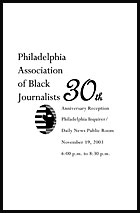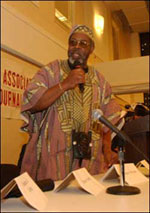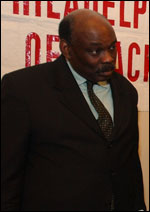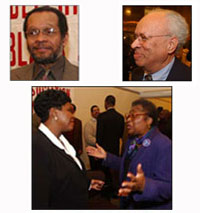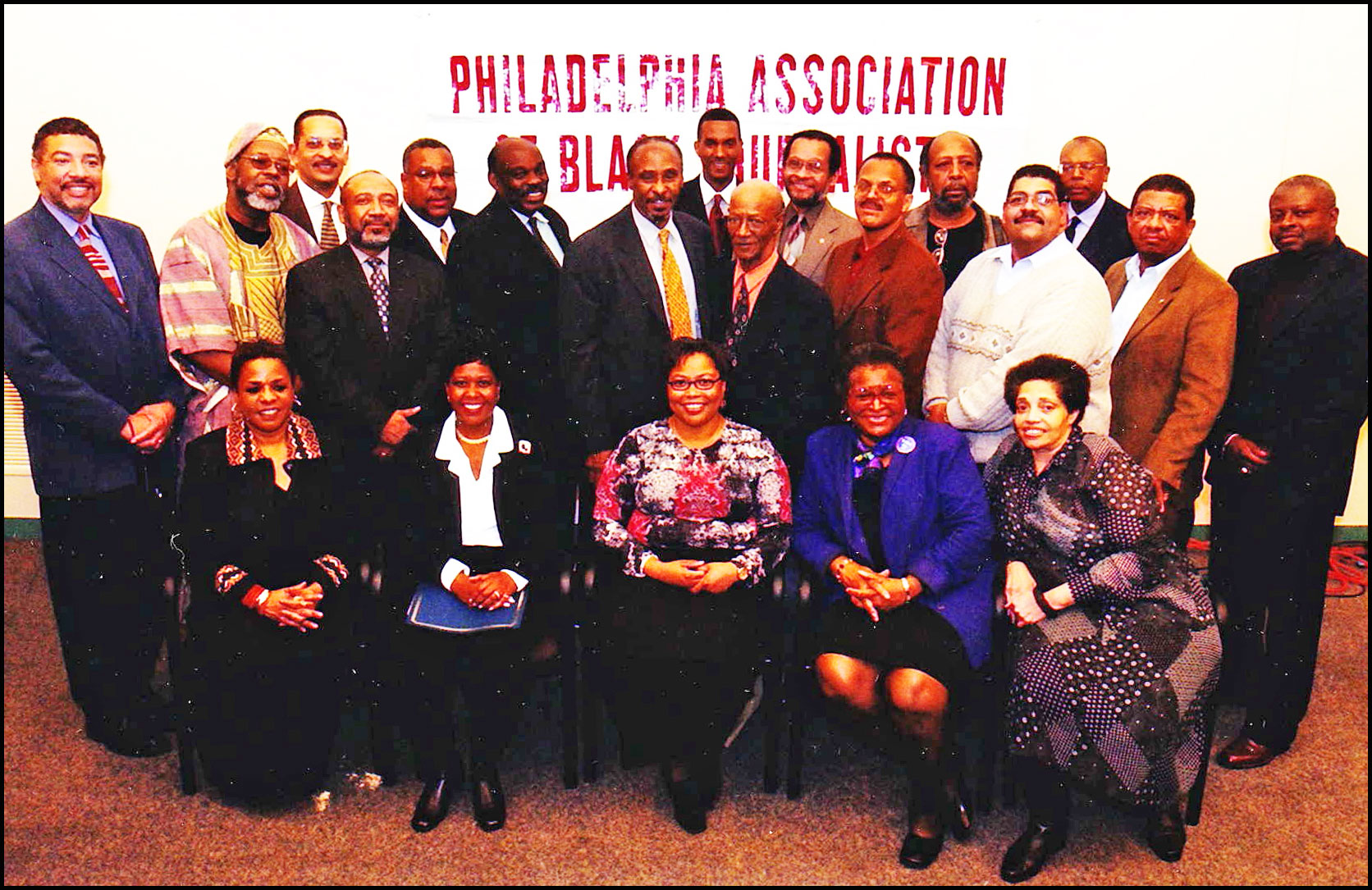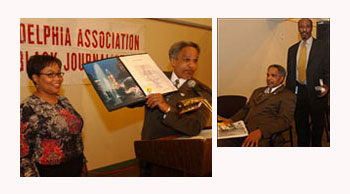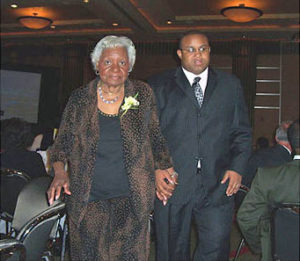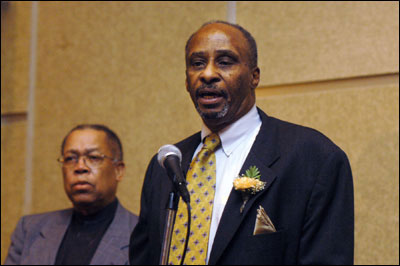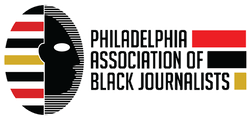OLD FRIENDS RECALL OUR BEGINNINGS
This article was written for the PABJ website in 2003 on the celebration of what was believed to be the 30th anniversary of ABJ/PABJ. The organization was officially founded in 1974.
By Al Hunter Jr.
Former President, PABJ
Inside a newspaper building that once shunned black reporters, 130 people celebrated the 30th anniversary of the Philadelphia Association of Black Journalists.
The reception and a panel discussion featuring PABJ founders and early chapter members were held Nov. 19, 2003, in the Public Room at the Philadelphia Inquirer/Daily News building in Philadelphia. Filled with black veteran journalists and young aspiring writers and broadcasters, the room was charged with nostalgia, hope and talk of unfinished work.
Journalists who wanted better representation of blacks in news stories and a greater black presence in newsrooms founded PABJ in 1973. They also wanted to establish a social and professional support network for blacks in the business. PABJ was the template for the National Association of Black Journalists, created in 1975.
“We all came together because we believed in something that we didn’t find among us here in the city,” Paul Bennett, who helped write PABJ’s first set of bylaws, said during the panel discussion. “What we tried to do was put together an organization that would be an advocacy group that would advance our issues, that would represent our folks. We had our successes, we had our trials and tribulations.”
Acel Moore, who rose from copy boy in 1962 to Pulitzer Prize-winning reporter in 1977 to columnist and associate editor at the Philadelphia Inquirer and was a PABJ founding member, said there had been previous attempts to organize, including a group called Black Communicators in 1968.
The organizing efforts showed that black journalists knew they had “more impact across the board than what lawyers were doing, what physicians were doing because we were communicating ideas and thoughts,” said Moore, who was also one of the founders of NABJ. “And really, the story of black people in America was not being told with accuracy or sensitivity.”
In 1973, less than 2 percent of the journalists at daily newspapers were black, Moore said. The percentage in broadcast was “a little higher” because of an edict from the Federal Communications Commission in the late 1960s, but the number hadn’t reached double digits, he said.
(According to the American Society of Newspapers Editors survey, blacks made up 5.3 percent of people working in newsrooms in 2002.)
Black journalists believed they could “apply pressure on the industry from within to increase our numbers and tell our story in a more accurate portrayal of what it was to be black and living in America,” Moore said.
Francine Cheeks, who was working at WCAU-TV at the time, noted that television pioneers such as Edie Huggins and Trudy Haynes and others “struggled and were alone an awful lot,” because there were few other blacks in the field. PABJ was the first group to unite print and broadcast professionals.
John F. Street, Philadelphia’s freshly re-elected mayor, read a city proclamation honoring PABJ’s 30th anniversary. In a separate interview, Street said black journalists are critical in providing the “appropriate balance in the reporting and getting a variety of perspectives into the political mainstream.” PABJ cosponsored a mayoral debate between Street and challenger Sam Katz on Oct. 9, 2003.
PABJ’s first president, Chuck Stone, a former Philadelphia Daily News columnist who is now a professor at the University of North Carolina in Chapel Hill, was unable to attend. But Daily News columnist Elmer Smith, another panelist, read a statement from him.
The panel included Sandra Long, a deputy managing editor at The Inquirer; J. Whyatt “Jerry” Mondesire, president of the local branch of the NAACP and president of the Philadelphia Sunday Sun; Reggie Bryant, radio talk-show host at WHAT-AM (1340); Joe Davidson, former Philadelphia Bulletin reporter, and Sam Pressley, director of public relations at Lincoln University.
NABJ president Herb Lowe said the 3,100-member national group is “fighting the struggle” started by PABJ. “We are carrying forth, understanding that it’s not about the programs we put on, but it’s about survival … and influence.” A former Inquirer reporter now with Newsday, Lowe noted that of the 15 national presidents, he’s the fifth with ties to the Philadelphia chapter.
Before presenting PABJ President Denise Clay with a proclamation from NABJ, Lowe asked members to remain involved with their local chapters. “There are chapters right now that are imploding from inside,” he said, because members have stopped giving their time to them. “Don’t leave the chapter. Stay there.”
Even after 30 years, there’s much work to be done, panelists said. The fact that the celebration was held at the Inquirer/Daily News building wasn’t lost on Mondesire.
He recalled that when Moore was promoted to reporter at The Inquirer, white editors at the paper, then owned by billionaire media mogul Walter H. Annenberg, started a betting pool to see how long Moore would last.
Annenberg “did not want black people here,” Mondesire said. He said that PABJ must become more of an advocacy group.
Bryant was critical of the mainstream newspapers, especially the Daily News that “should be published on Scott (toilet) paper.”
“This is a war. You are battle warriors,” Bryant said, addressing the Temple University students and young journalists from the North Philly Metropolis community paper who were in the audience. PABJ should be putting “a little starch in the collars and backbone” of these youngsters, he said.
Bennett urged the aspiring and current journalists to take a stand when they come across it.
“It happened then. It happens now. It’s going to happen in the future,” Bennett said. “Your job is to be there. Your job is to show up. Your job is to speak out. Your job is to confront it when and where it happens.”
Early and later members of ABJ at 2003 celebration:
Sitting, from left: Karen Warrington, Sandra Long, Denise Clay, Francine Cheeks, Charyn Sutton. Standing, from left: Linn Washington, Reggie Bryant, J. Whyatt “Jerry” Mondesire, Joe Blake, Vernon Odom, Elmer Smith, Acel Moore, Herbert Lowe, Kendall Wilson, Harold Yates, Joe Davidson, Don camp, Paul Bennett, Sam Pressley, Tyree Johnson, Michael Days. Photo by Sarah Glover.
At left, Philadelphia Mayor John street presents a proclamation to PABJ president Denise Clay in 2003. At right, Acel Moore stands near the mayor.
____________________________________________________________
TRAILBLAZERS HONORED AT 2005 & 2006 BANQUETS
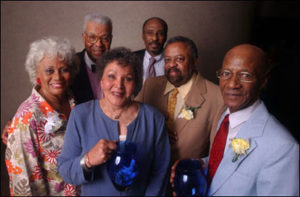
From left, clockwise: Trudy Haynes, Chuck Stone, Acel Moore, Claude Lewis, Kendall Wilson and Edie Huggins (center) at the 2005 banquet.
_______________________________________
Mal Johnson and Manuel McDonnell-Smith at the 2006 banquet.
_________________________________________
2006 awardees: From left, Francine Cheeks, Greg Morrison (in rear), Mal Johnson, Malcolm Poindexter, Joe Davidson (behind Poindexter), Reggie Bryant, Sonny Driver, Sirage Yassin (in rear), Denise James, Renita Burns and Kia Gregory (behind Burns).
_______________________________________
Acel Moore (right) and Paul Brock (the first executive director of NABJ) at the 2006 banquet.
____________________________________________________________
2018 celebration of founders, early and later members
These pioneers were honored at the 2018 PABJ banquet. From left: Tyree Johnson, Beverly Williams, Trudy Haynes, Don Camp (in rear), Sandra Long Weaver, Karen Warrington, Joe Davidson (in rear), Francine Cheeks, Melony Roy (then-current PABJ president), Elmer Smith, Vernon Odom and Sam Pressley.
